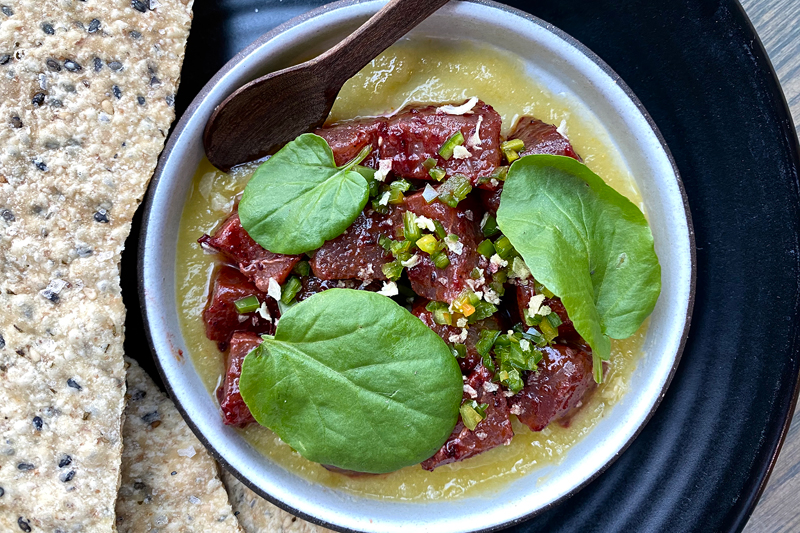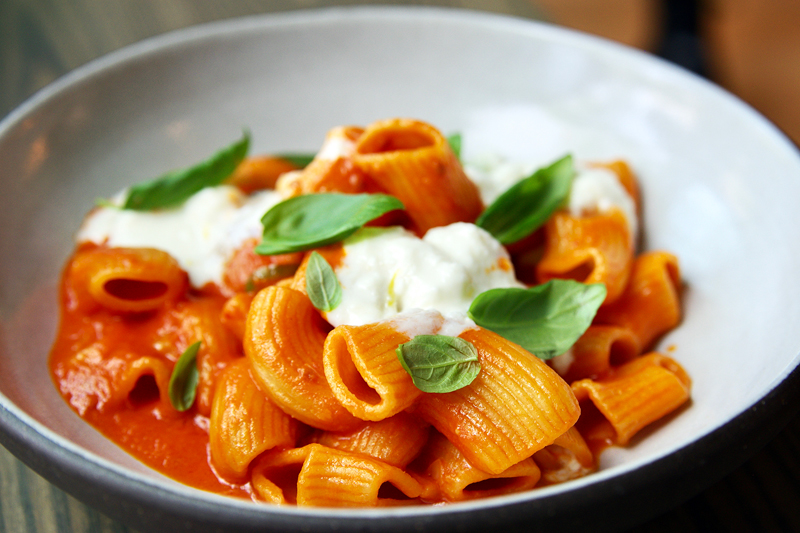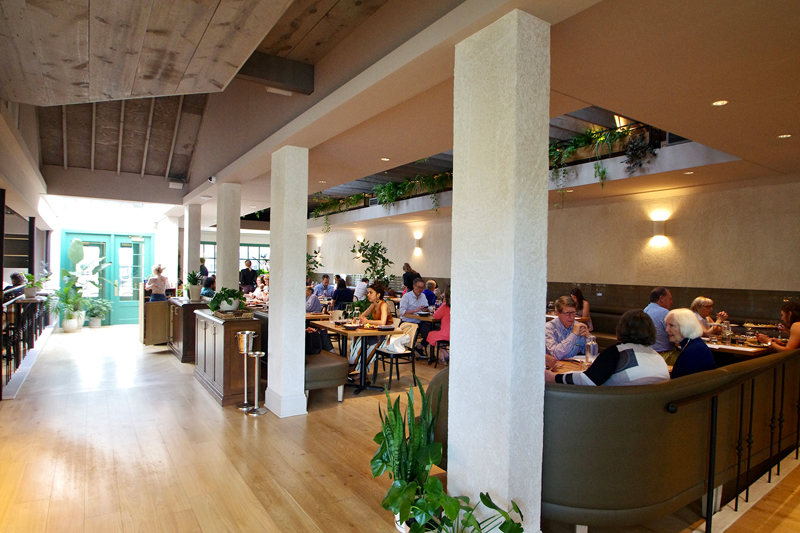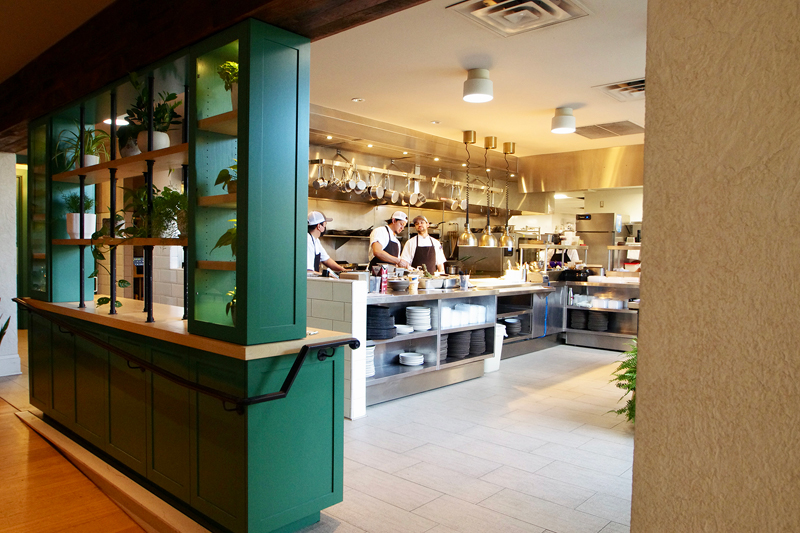PHOTOS BY BRENDA JOHNSON
The first pleasure that came roaring back as we sat down, indoors, to break our pandemic streak of home-dining, was the anticipation. After fourteen or so months, we no longer wondered how our favorite Indian takeout or well-worn cookbook recipes might taste. But with an unfamiliar menu before us, an adventurous cooking team in the kitchen, and a well-informed waiter eager to talk food right there at our table, the thrill of possibility was suddenly back.
At Josefina, seated at a respectful distance and surrounded by stiff new booths and a profusion of plants, we overflowed with questions and dithered over our options. At first glance, some of the prices seemed steep, but the menu descriptions were enticing, almost musical after all these months. Which dish, we wondered, would be the one to make us push back our chairs, wipe our lips, and think, or shout, “Damn!” “Holy Smokes!” or simply “Wow!”
 Pre-pandemic dining experiences at two of Chef Daniel del Prado’s other restaurants, Colita and Martina, prepared us for some ebullient swearing. And sure enough, we murmured an elongated “Fuuuuuuck” as we dug into our first course, an artfully presented dish of bigeye tuna crudo ($17) that highlighted del Prado’s adventurous flavor and color combinations: the raw fish, rich and ruby-red; tangy Meyer lemon sauce the color of yellow Crayola crayons; and green flecks of spicy serrano chile. Across the table came the vegetarian’s highest vicarious appreciation: “It’s wonderful seeing you get lost in a meal again.”
Pre-pandemic dining experiences at two of Chef Daniel del Prado’s other restaurants, Colita and Martina, prepared us for some ebullient swearing. And sure enough, we murmured an elongated “Fuuuuuuck” as we dug into our first course, an artfully presented dish of bigeye tuna crudo ($17) that highlighted del Prado’s adventurous flavor and color combinations: the raw fish, rich and ruby-red; tangy Meyer lemon sauce the color of yellow Crayola crayons; and green flecks of spicy serrano chile. Across the table came the vegetarian’s highest vicarious appreciation: “It’s wonderful seeing you get lost in a meal again.”
 None of the other dishes we tried rose to the level of the tuna crudo, but a couple came close. There were murmurs of deep appreciation, for instance, as the thin sear on the halibut ($35) crackled under a butter knife—a dish vividly paired with charred cabbage and polka-dotted with slivers of pickled red chile. We grinned at the panna cotta, served with syrupy strawberries and crumble ($10), all creamy perfection (a particular joy when so many competitors’ iterations are runny, rubbery, and/or overwhelmingly sweet).
None of the other dishes we tried rose to the level of the tuna crudo, but a couple came close. There were murmurs of deep appreciation, for instance, as the thin sear on the halibut ($35) crackled under a butter knife—a dish vividly paired with charred cabbage and polka-dotted with slivers of pickled red chile. We grinned at the panna cotta, served with syrupy strawberries and crumble ($10), all creamy perfection (a particular joy when so many competitors’ iterations are runny, rubbery, and/or overwhelmingly sweet).
 As expected, Josefina’s trattoria fare is very good. A simple pizza topped with mozzarella, basil, and parmesan ($14) checked all the boxes: nice char, chewy crust, and first-rate, unadulterated ingredients that play well together. Though impressive and larger than described, the pizza didn’t trigger table slaps or cursing fits—likely because we ate more than our fair share of excellent wood- or coal-fired pizza while holed up in quarantine. Del Prado dresses up humble farro with a heap of fresh herbs, pistachios, and peas ($15)—a salad combo we’ll definitely try to replicate this summer. We’ll also follow the chef’s lead and use fresh slices of chile, rather than red pepper flake, and liberal dollops of burrata when trying to impress friends with homemade Rigatoni Diavolo ($19). If only we had the noodle-making chops to reproduce Josefina’s deliciously toothsome rigatoni.
As expected, Josefina’s trattoria fare is very good. A simple pizza topped with mozzarella, basil, and parmesan ($14) checked all the boxes: nice char, chewy crust, and first-rate, unadulterated ingredients that play well together. Though impressive and larger than described, the pizza didn’t trigger table slaps or cursing fits—likely because we ate more than our fair share of excellent wood- or coal-fired pizza while holed up in quarantine. Del Prado dresses up humble farro with a heap of fresh herbs, pistachios, and peas ($15)—a salad combo we’ll definitely try to replicate this summer. We’ll also follow the chef’s lead and use fresh slices of chile, rather than red pepper flake, and liberal dollops of burrata when trying to impress friends with homemade Rigatoni Diavolo ($19). If only we had the noodle-making chops to reproduce Josefina’s deliciously toothsome rigatoni.
Of the seven dishes we tried, only one, a side of brussels sprouts ($11), missed. The deep-fried leaves were notably crispy, yet we couldn’t get past the misuse of agrodolce. Unevenly distributed, the sweet condiment took over, an intrusive helicopter parent stifling its weird kid’s innate appeal. An unappetizing pool of oil accumulating beneath didn’t do the dish any favors.
 But as the meal progressed, all that anticipation was starting to feel more like unease. It wasn’t just that the brussels sprouts didn’t measure up to the tuna crudo. We were increasingly uncomfortable. Because our small table was pinned against the wall, it was physically awkward and a bit tough on the elbows. The decor, with the exception of the proliferation of plants, is actually rather austere and cold. Rather than the celebratory spirit of del Prado’s other restaurants, Josefina evokes a really nice museum cafe. The beautiful open kitchen hints at informality and conviviality, but it’s tucked toward the back of the restaurant, out of eyesight for most of the dining room and behind those seated at the bar. Time will surely help the space feel more lived-in, and perhaps loosened coronavirus restrictions will let the tables creep away from the walls. Still, the place wouldn’t go wrong with a few menu amplifying color-field paintings or a focused playlist to lend the distinctive, coherent atmosphere we associate with del Prado.
But as the meal progressed, all that anticipation was starting to feel more like unease. It wasn’t just that the brussels sprouts didn’t measure up to the tuna crudo. We were increasingly uncomfortable. Because our small table was pinned against the wall, it was physically awkward and a bit tough on the elbows. The decor, with the exception of the proliferation of plants, is actually rather austere and cold. Rather than the celebratory spirit of del Prado’s other restaurants, Josefina evokes a really nice museum cafe. The beautiful open kitchen hints at informality and conviviality, but it’s tucked toward the back of the restaurant, out of eyesight for most of the dining room and behind those seated at the bar. Time will surely help the space feel more lived-in, and perhaps loosened coronavirus restrictions will let the tables creep away from the walls. Still, the place wouldn’t go wrong with a few menu amplifying color-field paintings or a focused playlist to lend the distinctive, coherent atmosphere we associate with del Prado.
But more than anything, our mounting unease was simple: Josefina seems like a place of, and for, rich people. Mind you, we understand that we are talking about what is arguably a chef-driven, special-occasion restaurant located in Wayzata, where the median household income is over $91,000. And there’s truly no issue with Josefina or any other restaurant targeting a select demographic (or simply finding that it’s attracting a clientele who carry purses that cost more than most people’s rent). It’s the little things, like not listing prices on the website, not-so-subtly suggesting, “If you have to ask, you can’t afford it.” Or servers describing entree-sized portions of pasta as side dishes, which seemed like upselling. Or not explaining a 4% “mandated” surcharge: Is that in lieu of or in addition to a regular tip? Does that mean the restaurant is providing health care and paid sick leave or that it’s trying to recoup some restaurant tax? [2] For rich patrons, these questions may not matter. But for people who save up for a special evening out, they surely do.
According to Josefina’s website, the restaurant “stems from del Prado’s desire to create an inclusive dining experience for all occasions.” If that’s the case, Josefina has a way to go.
Josefina, 739 Lake Street East, Wayzata, 952.208.9568, Sun-Thu 5-9pm, Fri-Sat 4-9pm

